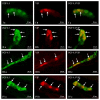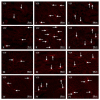The Impact of T-2 Toxin on Vasoactive Intestinal Polypeptide-Like Immunoreactive (VIP-LI) Nerve Structures in the Wall of the Porcine Stomach and Duodenum
- PMID: 29587461
- PMCID: PMC5923304
- DOI: 10.3390/toxins10040138
The Impact of T-2 Toxin on Vasoactive Intestinal Polypeptide-Like Immunoreactive (VIP-LI) Nerve Structures in the Wall of the Porcine Stomach and Duodenum
Abstract
T-2 toxin is a secondary metabolite of some Fusarium species. It is well-known that this substance can harmfully impact living organisms. Among others, thanks to the ability of crossing the blood-brain barrier, T-2 toxin can affect the central nervous system. Mycotoxins mostly get into the organism through the digestive tract; therefore, first of all they have to break the intestinal barrier, wherein the important component is the enteric nervous system (ENS). However, knowledge about the impact of T-2 toxin on the ENS is rather scant. As a result of the influence of various physiological and pathological agents, ENS can undergo adaptive and reparative processes which manifest as changes in the immunoreactivity of perikaryons for neuronal active substances. So, the aim of the present investigation was to study how low doses of T-2 toxin affect vasoactive intestinal polypeptide-like immunoreactive (VIP-LI) nervous structures in the ENS of the porcine stomach and duodenum. Obtained results have shown that T-2 toxin causes an percentage increase of VIP-LI nerve cells and nerve fibers in every enteric plexus in both fragments of gastrointestinal tract studied. This shows that even low doses of T-2 toxin can have an influence on living organisms.
Keywords: T-2 toxin; enteric nervous system; pig; vasoactive intestinal polypeptide.
Conflict of interest statement
There are no conflict of interest to declare.
Figures




Similar articles
-
T2 Toxin-Induced Changes in Cocaine- and Amphetamine-Regulated Transcript (CART)-Like Immunoreactivity in the Enteric Nervous System Within Selected Fragments of the Porcine Digestive Tract.Neurotox Res. 2017 Jan;31(1):136-147. doi: 10.1007/s12640-016-9675-8. Epub 2016 Oct 13. Neurotox Res. 2017. PMID: 27738989 Free PMC article.
-
The Influence of Low Doses of Zearalenone and T-2 Toxin on Calcitonin Gene Related Peptide-Like Immunoreactive (CGRP-LI) Neurons in the ENS of the Porcine Descending Colon.Toxins (Basel). 2017 Mar 10;9(3):98. doi: 10.3390/toxins9030098. Toxins (Basel). 2017. PMID: 28287437 Free PMC article.
-
Chemically induced inflammation and nerve damage affect the distribution of vasoactive intestinal polypeptide-like immunoreactive (VIP-LI) nervous structures in the descending colon of the domestic pig.Neurogastroenterol Motil. 2018 Nov;30(11):e13439. doi: 10.1111/nmo.13439. Epub 2018 Aug 15. Neurogastroenterol Motil. 2018. PMID: 30109906
-
Role of vasoactive intestinal peptide and inflammatory mediators in enteric neuronal plasticity.Neurogastroenterol Motil. 2004 Apr;16 Suppl 1:123-8. doi: 10.1111/j.1743-3150.2004.00487.x. Neurogastroenterol Motil. 2004. PMID: 15066017 Review.
-
Vasoactive intestinal polypeptide: measurement, distribution and putative neurotransmitter function.Digestion. 1979;19(3):149-69. doi: 10.1159/000198339. Digestion. 1979. PMID: 39014 Review.
Cited by
-
Effects of Mycotoxins on the Intestine.Toxins (Basel). 2019 Mar 13;11(3):159. doi: 10.3390/toxins11030159. Toxins (Basel). 2019. PMID: 30871167 Free PMC article.
-
A Novel Modified Hydrated Sodium Calcium Aluminosilicate (HSCAS) Adsorbent Can Effectively Reduce T-2 Toxin-Induced Toxicity in Growth Performance, Nutrient Digestibility, Serum Biochemistry, and Small Intestinal Morphology in Chicks.Toxins (Basel). 2019 Apr 2;11(4):199. doi: 10.3390/toxins11040199. Toxins (Basel). 2019. PMID: 30987049 Free PMC article.
-
The T2 Toxin Produced by Fusarium spp. Impacts Porcine Duodenal Nitric Oxide Synthase (nNOS)-Positive Nervous Structures-The Preliminary Study.Int J Mol Sci. 2020 Jul 20;21(14):5118. doi: 10.3390/ijms21145118. Int J Mol Sci. 2020. PMID: 32698434 Free PMC article.
-
The Mycotoxins T-2 and Deoxynivalenol Facilitate the Translocation of Streptococcus suis across Porcine Ileal Organoid Monolayers.Toxins (Basel). 2024 Sep 1;16(9):382. doi: 10.3390/toxins16090382. Toxins (Basel). 2024. PMID: 39330840 Free PMC article.
-
T-2 Toxin-The Most Toxic Trichothecene Mycotoxin: Metabolism, Toxicity, and Decontamination Strategies.Molecules. 2021 Nov 14;26(22):6868. doi: 10.3390/molecules26226868. Molecules. 2021. PMID: 34833960 Free PMC article. Review.
References
-
- Lewis L., Onsongo M., Njapau H., Schurz-Rogers H., Luber G., Kieszak S., Nyamongo J., Backer L., Dahiye A.M., Misore A., et al. Kenya Aflatoxicosis Investigation Group. Aflatoxin contamination of commercial maize products during an outbreak of acute aflatoxicosis in eastern and central Kenya. Environ. Health Perspect. 2005;113:1763–1767. doi: 10.1289/ehp.7998. - DOI - PMC - PubMed
-
- Moretti A., Logrieco A.F., Susca A. Mycotoxins: An underhand food problem. Methods Mol. Biol. 2017;1542:3–12. - PubMed
Publication types
MeSH terms
Substances
LinkOut - more resources
Full Text Sources
Other Literature Sources
Research Materials

